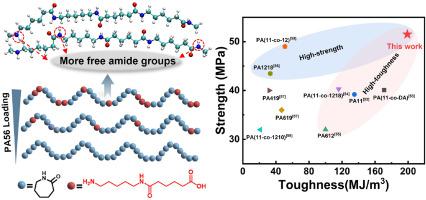Our official English website, www.x-mol.net, welcomes your
feedback! (Note: you will need to create a separate account there.)
Effect of comonomer loading on the thermal and mechanical properties of biobased copolyamides PA6/PA56
Polymer ( IF 4.1 ) Pub Date : 2024-04-18 , DOI: 10.1016/j.polymer.2024.127078
Ruishu Zhu , Lina Sun , Hongmei Hu , Runde Zhao , Bomou Ma , Naiqiang Li , Jianyong Yu , Xueli Wang , Longdi Cheng
Polymer ( IF 4.1 ) Pub Date : 2024-04-18 , DOI: 10.1016/j.polymer.2024.127078
Ruishu Zhu , Lina Sun , Hongmei Hu , Runde Zhao , Bomou Ma , Naiqiang Li , Jianyong Yu , Xueli Wang , Longdi Cheng

|
With bio-renewable and environmentally friendly nature, biobased polyamides have emerged as attractive alternatives to traditional petroleum-derived polymers. However, poor thermal and mechanical performance, high costs, and limited scalability significantly hinder their practical applications. Herein, a series of biobased copolyamides PA6/PA56 (CoPAs) were successfully synthesized from caprolactam, adipic acid, and the lysine-derived biobased monomers 1,5-pentanediamine. The copolyamides were characterized by gel permeation chromatography (GPC), nuclear magnetic resonance spectroscopy (H NMR), wide-angle X-ray diffraction (WAXD), differential scanning calorimetry (DSC), dynamic mechanical analysis (DMA), thermogravimetric analysis (TGA), rheological analysis, mechanical testing, and scanning electron microscopy (SEM). The result shows the α to γ transition in the crystalline form of the copolyamides with comonomer loading. The melting temperature, crystallization temperature, and crystallinity gradually decrease due to the introduction of the odd-even structure, causing deviation in amide positions and reducing hydrogen bond formation between molecular chains. Furthermore, variable-temperature infrared (VTIR) analysis and density functional theory (DFT) calculations further confirm a decrease in intermolecular forces. Importantly, the mobility of the molecular chains in the amorphous region is significantly improved, endowing the copolyamides with sufficient degrees of freedom to cope with externally applied strains. Moreover, significant entanglement facilitates effective stress transfer during stretching. As a result, the synthesized copolyamides achieve a high strength of 51 MPa and a remarkable toughness of 199 MJ/m, without sacrificing thermal stability and processing properties. These biobased CoPAs show great potential and prospects in the field of high-performance thermoplastic materials, films, and textiles.
中文翻译:

共聚单体用量对生物基共聚酰胺 PA6/PA56 热性能和机械性能的影响
生物基聚酰胺具有生物可再生性和环保性,已成为传统石油衍生聚合物的有吸引力的替代品。然而,较差的热性能和机械性能、高成本和有限的可扩展性严重阻碍了它们的实际应用。在此,由己内酰胺、己二酸和赖氨酸衍生的生物基单体1,5-戊二胺成功合成了一系列生物基共聚酰胺PA6/PA56(CoPA)。采用凝胶渗透色谱(GPC)、核磁共振波谱(H NMR)、广角X射线衍射(WAXD)、差示扫描量热法(DSC)、动态力学分析(DMA)、热重分析(TGA)对共聚酰胺进行了表征。 )、流变分析、机械测试和扫描电子显微镜(SEM)。结果表明,负载共聚单体的共聚酰胺的结晶形式发生了 α 到 γ 转变。由于奇偶结构的引入,熔融温度、结晶温度和结晶度逐渐降低,导致酰胺位置的偏差,减少分子链之间氢键的形成。此外,变温红外(VTIR)分析和密度泛函理论(DFT)计算进一步证实了分子间力的减小。重要的是,非晶区分子链的迁移率显着提高,赋予共聚酰胺足够的自由度来应对外部施加的应变。此外,显着的缠结有利于拉伸过程中有效的应力传递。结果,合成的共聚酰胺在不牺牲热稳定性和加工性能的情况下实现了 51 MPa 的高强度和 199 MJ/m 的卓越韧性。这些生物基CoPA在高性能热塑性材料、薄膜和纺织品领域显示出巨大的潜力和前景。
更新日期:2024-04-18
中文翻译:

共聚单体用量对生物基共聚酰胺 PA6/PA56 热性能和机械性能的影响
生物基聚酰胺具有生物可再生性和环保性,已成为传统石油衍生聚合物的有吸引力的替代品。然而,较差的热性能和机械性能、高成本和有限的可扩展性严重阻碍了它们的实际应用。在此,由己内酰胺、己二酸和赖氨酸衍生的生物基单体1,5-戊二胺成功合成了一系列生物基共聚酰胺PA6/PA56(CoPA)。采用凝胶渗透色谱(GPC)、核磁共振波谱(H NMR)、广角X射线衍射(WAXD)、差示扫描量热法(DSC)、动态力学分析(DMA)、热重分析(TGA)对共聚酰胺进行了表征。 )、流变分析、机械测试和扫描电子显微镜(SEM)。结果表明,负载共聚单体的共聚酰胺的结晶形式发生了 α 到 γ 转变。由于奇偶结构的引入,熔融温度、结晶温度和结晶度逐渐降低,导致酰胺位置的偏差,减少分子链之间氢键的形成。此外,变温红外(VTIR)分析和密度泛函理论(DFT)计算进一步证实了分子间力的减小。重要的是,非晶区分子链的迁移率显着提高,赋予共聚酰胺足够的自由度来应对外部施加的应变。此外,显着的缠结有利于拉伸过程中有效的应力传递。结果,合成的共聚酰胺在不牺牲热稳定性和加工性能的情况下实现了 51 MPa 的高强度和 199 MJ/m 的卓越韧性。这些生物基CoPA在高性能热塑性材料、薄膜和纺织品领域显示出巨大的潜力和前景。































 京公网安备 11010802027423号
京公网安备 11010802027423号